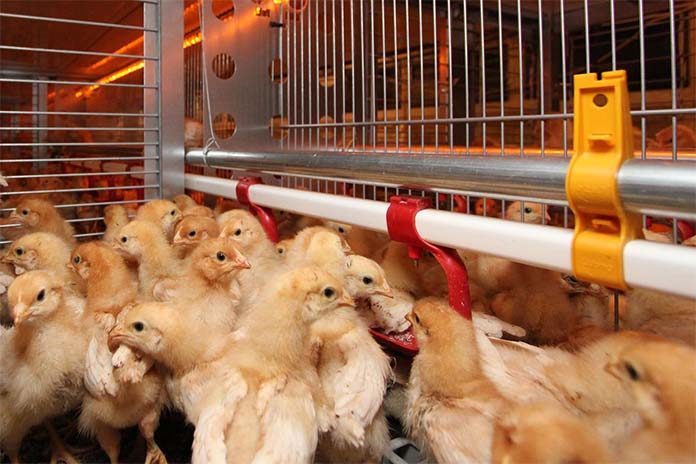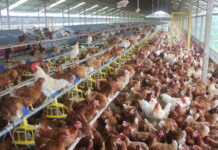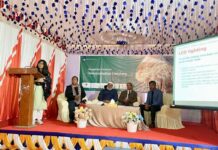
Productive and profitable layers begin with good quality pullets. Having the correct body weight and body type at the start of egg production will enable pullets to achieve their genetic potential.
Brooding period – getting off to a good start
Pullet chicks arriving to the farm from the hatchery should be alert and active. Chicks must be vigorous enough to explore their new environment and quickly find feed and water. Eating feed and drinking water quickly will speed the development of healthy intestinal microflora and build resistance to enteric pathogens. During the first week of life, chicks must be provided with constant attention by the manager to ensure optimized temperature, humidity, lights, feed and water availability. The first 2 weeks of life are when the most significant problems for proper chick development can occur. The newly hatched chick is unable to regulate body temperature and must be provided the proper environmental conditions. Relative humidity during the first week should be above 40% to prevent dehydration, drying of mucus membranes and vent pasting. The use of heaters to maintain brooding temperature will reduce relative humidity.
Chicks raised on the floor in houses heated with brooder stoves or whole-house heating should be confined in brooder rings. Observe chick behavior to determine if the temperature is correct. Chicks should be uniformly distributed in the brooding area. Closely grouped chicks indicate low temperatures or excessive drafts. In cold environments chicks will often chirp with a distressed tone. Chicks that are too warm will appear lethargic and will try to move away from the heat source. Both heat and cold-distressed chicks can have pasty vents.
During the first week, chicks benefit from bright light conditions in the house. Minimum light intensity should be 30 lux with clocks set to 22 to 23 hours. Alternatively, if local regulations allow, an intermittent lighting program can be used (4 hours of light followed by 2 hours of darkness, repeated for the first 7 to 10 days). In order to encourage water consumption, keep cup drinkers full of water for the first 3 days or adjust water pressure to cause a hanging drop of water in nipple drinkers. Chicks that fail to adapt to their environment and are delayed in finding feed and water will die at 4 or 5 days of age when the yolk sac is depleted.
Additional considerations for floor-raised birds
Floor-raised pullets may use pan or chain feeders. For both feed systems, it is important to start chicks by feeding on paper, cardboard, or trays that are placed near the feed line. When the chicks first arrive, be sure either the pans or troughs are completely filled to help the chicks find the permanent feed source. Carefully monitor the control panel to ensure that all feeders on the line remain full. When using brooder rings, there may not be sufficient access to water.
Provide supplemental water with chick drinkers for the first week or two, or until the rings are opened up to full water access. If perches are integrated onto the feed or water lines, it is important to minimize manure build up. Water lines with perches should use small or no-drip cups, as large drip cups tend to collect manure from perching birds.
Many diseases affect floor-raised birds more than cage-raised birds. In particular, infectious bursal disease and coccidiosis must be well controlled to ensure good uniformity and weight gain. Veterinarians with knowledge of the local disease burden should be consulted to implement an appropriate control program.
Teach good behavior early
Pullets going into barn or aviary laying environments should be provided growing environments containing perches, water platforms or multi-tiered environments. While chicks are usually started on the floor, it is important to set up the platforms or enriched environment by 3-4 weeks of age. If water platforms are used, it is important that pullets continue to have access to water on the floor until the flock learns to jump. Complex environments teach pullets jumping and exploratory behaviors. Pullets raised in enriched growing environments adapt better to complex laying environments. By learning to jump and explore at an early age, adult behavioral problems such as piling or not utilizing all levels in a multi-tiered system can be reduced.
Human contact during the growing period socializes pullets and reduces stress. Walking the house perimeter multiple times daily during the growing period aids socialization and can improve nesting behavior in layers. Using the same type of drinkers in pullet and layer houses improves adaptation in the layer house.
Pullet development and weight
The pullet develops according to a well-orchestrated sequence of physiologic events. Pullets reaching or exceeding breed body weight targets during these developmental phases have the best chance to perform to genetic potential as layers. Interrupted growth during any of these developmental phases will result in hens lacking the body reserves and organ function to sustain high production as adult layers.
Body weight uniformity
Uniformity of body weights within a flock is as important as achieving the target average body weight. 85% uniformity is the goal during the growing period (85% of the individual bird weights are within 10% of the average). Poor pullet body weight uniformity complicates the proper feeding of the flock both in grow and lay. Another challenge resulting from poor uniformity is pullets coming into production at different times, with underweight hens producing small eggs.
Conclusion
Careful attention to the principles of pullet management is fundamental for success and profits in laying flocks. Growing a pullet flock of the correct weight and body conformation will usually ensure success in the laying period. Problems such as low egg numbers and poor egg shell quality during lay can often be traced back to problems occurring in the growing period.
References are available on request
From the Proceedings of the 2019 Midwest Poultry Federation Convention

















